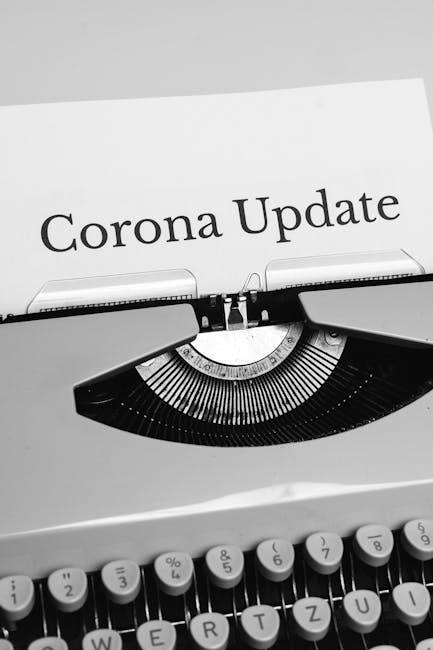A newsletter is a powerful communication tool designed to inform‚ engage‚ and connect with audiences. It serves as a platform for sharing updates‚ insights‚ and valuable content‚ fostering brand loyalty and trust. Originally distributed in print‚ modern newsletters have evolved into digital formats like PDFs‚ offering flexibility and wider reach. Businesses‚ organizations‚ and individuals use newsletters to deliver targeted messages‚ ensuring consistent communication and building meaningful relationships with their audience.
1.1 Definition and Purpose of Newsletters
A newsletter is a regularly distributed publication‚ typically digital or in print‚ designed to inform‚ engage‚ and connect with a specific audience. It serves as a platform for sharing news‚ updates‚ and educational content tailored to the interests of its readers. The primary purpose of a newsletter is to build relationships‚ establish authority‚ and deliver value to subscribers. Whether used by businesses‚ organizations‚ or individuals‚ newsletters aim to educate‚ entertain‚ or inspire‚ fostering loyalty and trust. PDF newsletters‚ in particular‚ are popular for their professional appearance and ease of distribution‚ making them a versatile tool in modern communication strategies.
1.2 Importance of Newsletters in Digital Marketing
Newsletters play a pivotal role in digital marketing by enabling businesses to connect directly with their audience. They serve as a versatile platform for generating leads‚ nurturing relationships‚ and strengthening client trust. Unlike transient social media posts‚ newsletters provide a personalized and engaging way to deliver tailored content‚ fostering brand loyalty. They also act as a cost-effective tool for sharing updates‚ promotions‚ and educational content‚ driving customer engagement and conversions. By leveraging email marketing platforms‚ businesses can ensure their newsletters reach targeted audiences‚ making them a cornerstone of modern digital marketing strategies. Their effectiveness lies in their ability to build lasting connections and deliver measurable results.

Design Elements of a PDF Newsletter
A well-designed PDF newsletter combines visually appealing layouts‚ consistent color schemes‚ and readable fonts to create an engaging and professional reader experience‚ enhancing brand identity and content clarity.
2.1 Layout and Structure
A well-organized layout is essential for a PDF newsletter‚ ensuring readability and visual appeal. Start with a clear header containing your logo and newsletter title. Use grids or columns to align content neatly‚ making it easy to scan. Prioritize white space to avoid clutter and enhance readability. Organize information into clear sections‚ such as headlines‚ articles‚ and CTAs‚ using headings and subheadings to guide readers. Ensure consistent spacing between elements and use visual hierarchy to draw attention to key content. A structured layout enhances user experience‚ making your newsletter both professional and engaging. Proper alignment and balance are critical for a polished look.
2.2 Color Schemes and Branding
A well-chosen color scheme is vital for a PDF newsletter‚ as it enhances readability and reinforces brand identity. Select colors that align with your brand’s palette‚ using a primary color for headers and accents‚ and secondary colors for backgrounds and text. Ensure high contrast between text and background for readability. Consistent branding elements‚ such as logos and typography‚ should be prominently featured. Avoid overly bright or clashing colors that may distract readers. Use color sparingly to highlight key sections or calls-to-action. The color scheme should reflect your brand’s personality while maintaining a professional and visually appealing design that engages your audience effectively.
2.3 Fonts and Typography
Choosing the right fonts and typography is crucial for a PDF newsletter’s readability and aesthetic appeal. Select fonts that align with your brand’s identity‚ ensuring consistency across all communications. Use clear‚ legible fonts for body text‚ such as Arial‚ Helvetica‚ or Georgia‚ while reserving bold or decorative fonts for headings to create visual hierarchy. Proper spacing‚ font size‚ and line height are essential for readability. Avoid using too many font styles‚ as this can clutter the design. Ensure that typography is responsive‚ adapting well to different screen sizes. The goal is to balance visual appeal with functionality‚ making your newsletter easy to read and engaging for your audience.
2.4 Visual Elements (Images‚ Icons‚ and Graphics)
Visual elements like images‚ icons‚ and graphics play a vital role in enhancing the appeal of a PDF newsletter. High-quality images can capture attention‚ convey messages‚ and break up text‚ making the content more engaging. Icons and graphics can highlight key points‚ illustrate data‚ or add visual interest. Infographics are particularly effective for presenting information in an easily digestible format. Ensure images are optimized for PDF to maintain clarity without increasing file size excessively. Align visuals with your brand’s aesthetic and use them sparingly to avoid clutter. Tools like Canva or Adobe InDesign can help create professional-looking visuals that elevate your newsletter’s design.

Content Creation for Newsletters
Creating compelling content for newsletters involves crafting engaging headlines‚ concise copy‚ and relevant calls-to-action. It’s about delivering value‚ insights‚ and maintaining a consistent brand voice to build audience connection.
3.1 Crafting a Compelling Headline
A compelling headline is the first step in capturing audience attention. It should be clear‚ concise‚ and tailored to the newsletter’s purpose. Personalization‚ such as using the recipient’s name‚ can enhance engagement. Focus on highlighting benefits or exclusive content to pique curiosity. Avoid overly clever language that may confuse readers. Instead‚ aim for simplicity and directness. Including numbers or actionable verbs can make headlines more impactful. For example‚ “Unlock 10 Tips to Boost Productivity” or “Exclusive Discount Inside.” The headline should also align with the newsletter’s content to set expectations. Keeping it brief‚ ideally under ‚ ensures readability‚ especially in PDF formats.
3.2 Writing Engaging and Concise Copy
Writing engaging and concise copy is crucial for maintaining reader interest in a PDF newsletter. Use clear‚ simple language that speaks directly to your audience’s needs and interests. Break down complex ideas into short‚ digestible paragraphs or bullet points. Focus on the benefits your readers will gain‚ whether it’s valuable insights‚ tips‚ or exclusive offers. Avoid jargon and keep sentences straightforward. Incorporate a conversational tone to make the content relatable and approachable. Ensure every section flows logically to the next‚ guiding readers seamlessly through the newsletter. Always include a strong call-to-action to encourage engagement or further interaction. Personalize content when possible to enhance relevance and connection.
3.3 Including Calls-to-Action (CTAs)
Including effective calls-to-action (CTAs) in your PDF newsletter is essential for driving reader engagement and conversions. CTAs should be clear‚ actionable‚ and strategically placed throughout the content. Use buttons‚ hyperlinks‚ or QR codes to make CTAs stand out. Ensure they are visually appealing by using contrasting colors and bold typography. Place CTAs near key sections‚ such as after compelling headlines or exclusive offers‚ to encourage immediate action. Personalize CTAs when possible to enhance relevance. Avoid overcrowding the newsletter with too many CTAs‚ as this can distract from the primary message. Always test CTAs to ensure they are functional and track their performance to refine future strategies. Well-crafted CTAs can significantly boost engagement and achieve your marketing goals.
3.4 Personalization Strategies
Personalization is a powerful way to make your PDF newsletter more engaging and relevant to your audience. Start by using the recipient’s name in the subject line or greeting. Segment your email list to tailor content based on demographics‚ preferences‚ or past interactions. Use dynamic content to display different sections or offers to specific groups. Incorporate personalized recommendations‚ such as product suggestions or event invitations‚ to create a unique experience. Leverage data analytics to identify patterns and refine your approach. Finally‚ include personalized calls-to-action (CTAs) to encourage specific actions. Personalization fosters a deeper connection‚ increasing engagement and satisfaction with your newsletter.

Distribution Channels for PDF Newsletters
Effective distribution channels for PDF newsletters include email marketing‚ social media platforms‚ websites‚ and blogs. These methods ensure maximum reach and engagement with your target audience.
4.1 Email Marketing Platforms
Email marketing platforms are a primary channel for distributing PDF newsletters‚ enabling direct delivery to subscribers’ inboxes; Platforms like Mailchimp‚ HubSpot‚ and Campaign Monitor offer tools to create‚ send‚ and track newsletter campaigns. These platforms support PDF attachments‚ making it easy to share visually appealing and structured content. They also provide customizable templates‚ subscriber list management‚ and analytics to monitor performance. Personalization features allow tailoring content to specific audience segments‚ enhancing engagement. Additionally‚ automation capabilities streamline the distribution process‚ ensuring consistent delivery. Email marketing platforms remain a cornerstone of effective PDF newsletter distribution‚ offering both simplicity and advanced functionality for marketers.
4.2 Social Media and Online Platforms
Social media and online platforms are powerful channels for sharing PDF newsletters‚ enabling widespread reach and engagement. Platforms like LinkedIn‚ Twitter‚ and Facebook allow users to upload or link PDFs directly‚ making it easy to share content with followers. Professional networks like LinkedIn are particularly effective for corporate or industry-specific newsletters. Additionally‚ online communities such as Reddit or niche forums can be used to target specific audiences. Sharing PDF newsletters on these platforms can drive traffic to your website or blog. However‚ ensure compliance with platform guidelines to avoid spam flags. Social media analytics can also help track engagement and refine distribution strategies.
4.3 Websites and Blogs
Websites and blogs serve as ideal platforms for hosting and sharing PDF newsletters. By embedding links or PDF viewers directly into web pages‚ audiences can easily access content without leaving the site. Blogs often feature newsletter archives‚ allowing readers to browse past issues. Dedicated newsletter sections on websites enhance user experience and encourage subscriptions. Additionally‚ embedding CTAs within blog posts or website sidebars can drive traffic to newsletter sign-up pages. Websites also offer SEO benefits‚ as hosted PDFs can improve search visibility. Regularly updating blogs with newsletter content ensures fresh material for visitors and search engines‚ fostering engagement and loyalty over time.

Tools for Creating PDF Newsletters
Various tools simplify PDF newsletter creation‚ from design software like Canva and Adobe InDesign to email platforms like Mailchimp and HubSpot‚ ensuring professional and polished outputs.
5.1 Design Software (Canva‚ Adobe InDesign)
Design software like Canva and Adobe InDesign are essential for creating visually appealing PDF newsletters. Canva offers user-friendly templates and drag-and-drop features‚ perfect for quick‚ professional designs. Adobe InDesign provides advanced tools for complex layouts‚ ideal for corporate or high-end newsletters. Both platforms allow customization of colors‚ fonts‚ and images‚ ensuring brand consistency. Canva’s affordability and accessibility make it a favorite for small businesses‚ while InDesign’s scalability suits large organizations. These tools empower creators to craft engaging‚ visually stunning newsletters that captivate audiences and convey their message effectively‚ whether for marketing‚ education‚ or non-profit purposes.
5.2 Email Marketing Tools (Mailchimp‚ HubSpot)
Email marketing tools like Mailchimp and HubSpot are crucial for distributing PDF newsletters efficiently. Mailchimp offers easy-to-use campaign builders‚ customizable templates‚ and automation features‚ making it ideal for small to medium-sized businesses. HubSpot provides advanced marketing automation‚ personalized content delivery‚ and analytics‚ catering to larger enterprises. Both platforms allow seamless integration with designed PDFs‚ enabling direct email distribution. They also offer tracking features to monitor metrics like open rates‚ click-through rates‚ and conversions. These tools enhance the reach and impact of newsletters‚ ensuring targeted delivery and maximizing engagement with the audience.
5.3 PDF Conversion Tools
PDF conversion tools are essential for transforming newsletter content into a professional‚ shareable format. Adobe Acrobat is a popular choice‚ offering robust features for converting documents like Word files or designs into PDFs while maintaining layout integrity. Smallpdf provides user-friendly online conversion‚ supporting multiple file types and ensuring high-quality output. Canva also offers PDF export options‚ ideal for designers creating newsletters directly within the platform. These tools allow creators to ensure their newsletters are visually consistent and easily accessible across devices. They also support features like compression‚ password protection‚ and meta-tagging‚ enhancing the newsletter’s functionality and security for distribution.

Legal and Compliance Considerations
Ensure newsletters comply with data protection laws like GDPR and CCPA. Avoid spam filters by adhering to email regulations and including unsubscribe options. Respect privacy policies and consent rules.
6.1 Data Protection and Privacy Laws
Newsletter creators must comply with data protection laws like GDPR and CCPA. Collecting personal data requires explicit consent‚ and subscribers must be informed about data usage. Privacy policies should be clear‚ and unsubscribe options must be easy to access. Ensuring data security is critical to prevent breaches. Newsletter platforms should have robust encryption and comply with international regulations. Regular audits and updated policies help maintain trust and avoid legal penalties. Transparency in data handling builds subscriber confidence and ensures legal compliance.
6.2 Spam Filters and Email Regulations
Newsletter distributors must navigate spam filters and email regulations to ensure delivery. Laws like the CAN-SPAM Act and GDPR require clear opt-out options and prohibit deceptive tactics. Avoiding spam triggers in subject lines and content is crucial. Authentication protocols like SPF and DKIM help emails pass spam filters. Segmenting audiences and maintaining a clean email list improve deliverability. Using reputable email services ensures compliance with regulations. Regularly testing emails with tools like Mailchimp or HubSpot can identify potential issues. Compliance with these rules enhances sender reputation and prevents emails from being flagged as spam‚ ensuring higher delivery rates and better engagement.

Tracking and Measuring Performance
Monitor key metrics like open rates‚ click-through rates‚ and engagement to evaluate newsletter success. Use analytics tools to track performance and refine future strategies effectively.
7.1 Key Metrics to Monitor
Track open rates‚ click-through rates‚ and conversion rates to gauge engagement. Measure time spent reading and sharing/forwarding rates to assess content impact. Monitor bounce rates and unsubscribe rates to identify delivery issues or audience dissatisfaction. Use these metrics to refine content‚ improve targeting‚ and enhance overall performance. Regularly analyzing these KPIs helps optimize future newsletters and ensures alignment with audience preferences and business goals.
7.2 A/B Testing Strategies
A/B testing‚ or split testing‚ is crucial for optimizing PDF newsletters. Test different subject lines‚ content layouts‚ and CTAs to identify what resonates best with your audience. Experiment with visuals‚ fonts‚ and color schemes to enhance readability and appeal. Send time and frequency can also be tested to maximize engagement. Analyze metrics like open rates‚ clicks‚ and conversions to determine the winning version. Continuously refine your approach based on data to improve engagement and achieve higher ROI. Regular A/B testing ensures your newsletters evolve to meet audience preferences and stay aligned with your marketing goals.

Examples of Effective PDF Newsletters
Effective PDF newsletters combine engaging visuals‚ clear content‚ and strong CTAs. They cater to diverse audiences‚ ensuring relevance and impact across industries‚ from corporate to non-profit sectors.
8.1 Corporate Newsletters
Corporate PDF newsletters are essential for internal and external communication‚ fostering engagement and trust. They typically feature company updates‚ industry insights‚ and employee spotlights‚ ensuring alignment with brand identity.
Effective corporate newsletters use clean layouts‚ professional color schemes‚ and concise language to convey key messages. They often include sections like “CEO Corner” or “Employee of the Month” to personalize content.
Visuals such as infographics and team photos enhance readability‚ while CTAs like event registrations or feedback surveys encourage interaction. Distributed via email or intranet‚ corporate newsletters are a powerful tool for building a connected‚ informed community.
8.2 Educational Newsletters
Educational PDF newsletters are vital for schools‚ universities‚ and training institutions to share knowledge and updates. They often feature event calendars‚ academic achievements‚ and resources for students and staff.
These newsletters use engaging layouts with vibrant colors to appeal to diverse audiences‚ including students‚ parents‚ and educators. Sections like “Student of the Month” or “Upcoming Workshops” highlight achievements and opportunities.
Incorporating images of school events or classroom activities makes the content relatable and inspiring. Distributed via email or school websites‚ educational newsletters foster a sense of community and support continuous learning. They also serve as a platform for sharing tips and strategies for academic success.
8.3 Non-Profit Newsletters
Non-profit PDF newsletters are essential for engaging donors‚ volunteers‚ and supporters. They typically highlight success stories‚ upcoming events‚ and ways to contribute.
These newsletters often include compelling visuals‚ testimonials‚ and clear calls-to-action to inspire involvement. Sections like “Impact of Your Donation” or “Volunteer Spotlight” foster trust and community connection.
Non-profits use these newsletters to share mission-driven content‚ fostering loyalty and encouraging continued support. Distributed via email or social media‚ they serve as a powerful tool for fundraising and advocacy‚ ensuring the organization’s goals remain front-of-mind for their audience.

Best Practices for PDF Newsletters
Keep content concise‚ visually appealing‚ and aligned with your audience’s interests. Use high-quality images‚ readable fonts‚ and ensure mobile optimization for seamless viewing across devices.
9.1 Consistency and Frequency
Consistency and frequency are vital for maintaining audience engagement with PDF newsletters. Establish a regular schedule‚ whether weekly‚ biweekly‚ or monthly‚ to build trust and anticipation. Ensure each issue follows a consistent format‚ including layout‚ branding‚ and tone‚ to reinforce recognition. However‚ avoid overwhelming subscribers with too frequent emails‚ as this can lead to unsubscribes. Balance is key to keeping your audience interested without causing fatigue; Additionally‚ personalize content to align with subscriber preferences and maintain high-quality standards in every issue to uphold your brand’s credibility and engagement levels over time.
9.2 Mobile Optimization
Mobile optimization is crucial for ensuring PDF newsletters are easily readable on all devices. Design your newsletter with a responsive layout that adapts to smaller screens‚ ensuring text and visuals remain clear and accessible. Use fonts that are legible on mobile devices and maintain adequate spacing between lines for readability. Optimize images and graphics to load quickly without compromising quality. Include alt text for images to improve accessibility. Ensure links and buttons are large enough for easy tapping. Test your newsletter across various devices to guarantee compatibility. Mobile-friendly PDFs enhance reader experience‚ making your content more accessible and engaging for on-the-go audiences.
9.4 Engaging Visual Content
Engaging visual content is essential for capturing readers’ attention in PDF newsletters. Use high-quality images‚ infographics‚ and charts to convey information succinctly. Incorporate brand-consistent colors and logos to maintain recognition. Balance visuals with text to avoid clutter. Ensure images are appropriately sized and compressed for fast loading. Add icons or illustrations to break up text and enhance readability. Use alt text for images to improve accessibility. Interactive elements like links or buttons can encourage engagement. Prioritize visuals that align with your message to create a professional and visually appealing newsletter. Well-designed visuals make your content more dynamic and shareable‚ enhancing reader engagement and retention.

Future Trends in PDF Newsletters
Future trends in PDF newsletters include interactive content‚ AI-driven personalization‚ and sustainable design practices‚ enhancing engagement and accessibility while aligning with environmental consciousness.
10.1 Interactive and Animated Content
Interactive and animated content is revolutionizing PDF newsletters‚ enhancing reader engagement. Embedded videos‚ animations‚ and clickable elements create immersive experiences. Readers can interact with polls‚ quizzes‚ or slideshows‚ fostering participation. Animated GIFs and hover effects add visual appeal without overwhelming the design. These features make newsletters more dynamic and shareable. However‚ balancing interactivity with performance is crucial‚ as excessive animations can slow loading times. Tools like Adobe InDesign and online platforms now support these elements‚ enabling marketers to craft engaging‚ modern PDF newsletters that captivate audiences and drive action. This trend is expected to grow‚ making newsletters more interactive and visually stimulating.
10.2 AI-Powered Personalization
AI-powered personalization is transforming PDF newsletters by tailoring content to individual preferences. Using machine learning algorithms‚ marketers analyze subscriber data to create customized content‚ ensuring relevance and engagement. AI can dynamically adjust headlines‚ imagery‚ and recommendations based on reader behavior and interests. This level of personalization enhances satisfaction and conversion rates. Additionally‚ AI tools automate content curation‚ saving time while improving accuracy. As AI technology advances‚ personalized PDF newsletters will become more sophisticated‚ offering readers unique‚ tailored experiences. This trend is expected to deepen customer connections and drive higher engagement in the future of digital marketing.
10.3 Sustainability in Digital Newsletters
Sustainability in digital newsletters focuses on reducing environmental impact while maintaining effectiveness. PDF newsletters are inherently eco-friendly‚ as they eliminate the need for paper‚ ink‚ and physical distribution. Companies can further enhance sustainability by optimizing file sizes to reduce energy consumption during transmission and storage. Additionally‚ AI tools can help minimize waste by ensuring content relevance‚ reducing unnecessary sends‚ and optimizing delivery times. Brands that prioritize sustainability in their newsletters often see increased trust and loyalty from environmentally conscious audiences. As global concern for the environment grows‚ sustainable practices in digital newsletters will become a key expectation for businesses worldwide.
PDF newsletters remain a powerful tool for engagement and communication‚ evolving with technology and audience needs. By embracing innovation and best practices‚ businesses can maximize their impact effectively.
11.1 Summary of Key Points
11.2 Final Thoughts on the Future of Newsletters
The future of PDF newsletters is poised for innovation‚ blending creativity with technology. Interactive content‚ such as animations and embedded videos‚ will enhance reader engagement. Artificial intelligence will play a key role in personalizing content‚ tailoring messages to individual preferences. Sustainability efforts may also shape the industry‚ as businesses opt for eco-friendly digital formats. Accessibility features‚ like screen-reader compatibility‚ will become standard. As tools evolve‚ creating professional-grade newsletters will become more accessible to smaller organizations. This dynamic medium will continue to adapt‚ offering brands a versatile way to connect with audiences while staying ahead of digital trends.